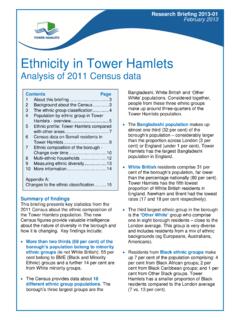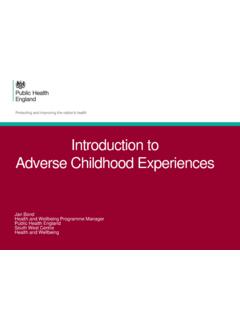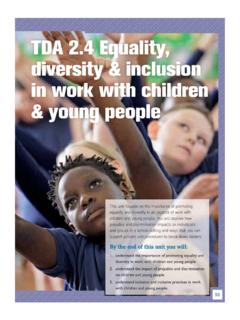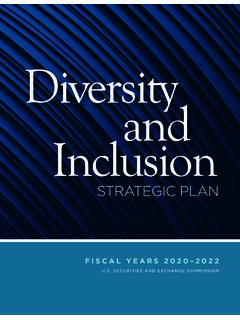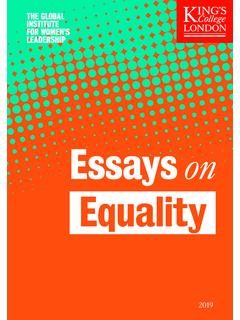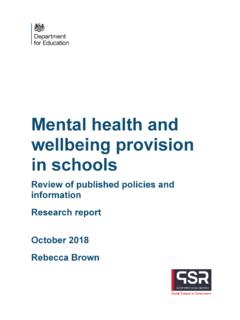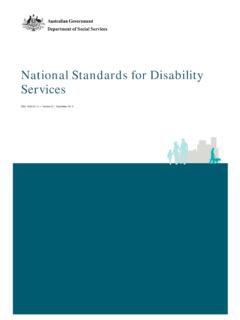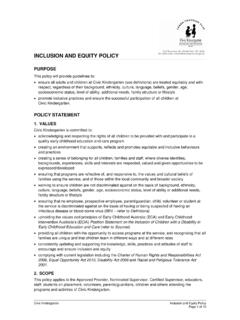Transcription of Equality Guidance for Early Years Settings
1 Equality Guidance for Tower Hamlets Council Early Years inclusion TeamEarly Years Settings3 Equality Guidance for Early Years SettingsAll Unique and All of Equal Value This publication aims to provide Early Years Settings with Guidance in supporting Equality and inclusive practice. It complements the Guidance for Early Years inclusion Coordinators, Tower Hamlets Council Early Years inclusion Team of the term parents refers to both parents and carers and use of the plural does not imply that the child will necessarily have two parents. Photographs represent a wide range of children in Tower would like to thank the Early Years Settings and their families who kindly agreed to photographs of children and staff being used for Early Years publications.
2 We would also like to express our gratitude to the children and families of Tower Hamlets who continue to inspire our :East Lothian Council Equality in the Early Years Suffolk County Council Guidance for Promoting Equalities in Early Years and Childcare March 2017 Equality Guidance for Early Years Settings4 Equality Guidance for Early Years SettingsIntroduction 5 Equality and the Law 8 Protected characteristics 9 Reasonable adjustments 11 Developing anti-discriminatory practice 11 Inclusive polices and practice 14 Inclusive planning for individual needs 19 Inclusive
3 Relationships and partnerships 24 Inclusive environments and approaches 28 Glossary of terms 32 Bibliography 34 Links and other sources of information 35 Contents5 Equality Guidance for Early Years SettingsIntroductionTower Hamlets is fortunate to be a borough with a wealth of cultures, religions and community languages. It is a rich and diverse community, with a history of continuous celebrating this diversity within Settings and communities, it is recognising that we are all unique and all of equal value.
4 Within the community, various groups have differing strengths and vulnerabilities. With some groups having particular needs. This publication provides Guidance , advice and support to help ensure Equality for all. It is not intended to be exhaustive, as individuals bring their own knowledge and expertise to developing Equality and child, like each adult, has intrinsic worth and should be treated with respect and care in all circumstances. Each child brings to each circumstance a unique personhood, identity, perspective and understanding that regardless of gender, ethnicity, sexuality, physical ability, language, religion, beliefs, social origin or any other status should be valued and nurtured.
5 Dignity is inherent and cannot be deserved or Rights Partners, An Introduction to Children s Rights in Practice, 2016 UNICEF UKInclusive policies and practiceInclusive planning for individual needsInclusive relationshipsand partnershipsInclusive environmentand approachesEQUALITY ANDINCLUSION6 Equality Guidance for Early Years SettingsThe aim of this Guidance is to support Early Years practitioners to continue to develop their inclusive ethos, policies and practices to include everyone with the aim of meeting their individual is important to remember that the provision of equal opportunities applies to everyone who has contact with or involvement in your setting, including: children, parents and families, staff, the wider community, other services and experiences and the influences of those around us, have an effect on the values and views held.
6 Stereotypical views of certain groups can get in the way of seeing the individual. It is important to acknowledge this in ourselves as well as in others. Bringing awareness to this and taking time to reflect will help us to better understand thoughts and actions. By refining and developing awareness, we are better placed to challenge ourselves and others when places that are inclusive of everyone means we can help to build an understanding that Equality and inclusion are important and create a greater understanding of the needs of different in the Early Years .
7 A guide to Equality and diversity for all those working in Early Years Services. East Lothian Council7 Equality Guidance for Early Years SettingsAll Settings and Early Years practitioners have a duty to promote understanding and appreciation of difference and diversity . This includes developing tolerance, respect and promoting cohesion. There is also a duty to actively challenge all forms of discrimination. It is not enough to be non-discriminatory in our own practice, we need to be anti-discriminatory, which means challenging others when they make discriminatory comments or act in a discriminatory to Equality and inclusive practice is valuing and having respect for all.
8 This Guidance outlines an approach where this is achieved through an active process of being aware of the situation, considering how to respond and taking time to reflect, in order to continually evaluate and improve Guidance for Early Years SettingsEquality and the LawThe Equality Act 2010 brings together a range of legislation into a single act. It provides the legal framework to protect the rights of individuals and promote Equality of opportunity for all. The requirements of the Equality Act, sit alongside other statutory requirements:zzThe Children and Families Act (2014)zzSpecial educational needs code of practice: 0 to 25 Years (2015)zzThe statutory framework for the Early Years foundation stage (2014)zzThe United Nations Convention on the Rights of the Child (1992) The Equality Act can be found at: For detailed information on specific duties and responsibilities for Early Years Settings under the Equality Act with regards to children with disabilities, see the publication.
9 Council for Disabled Children CDC (2015) Disabled Children and the Equality Act 2010: What Early Years providers need to know and do, including responsibilities to disabled children under the Children and Families Act 2014: Guidance for Early Years SettingsProtected CharacteristicsThe Equality Act 2010 sets out to ensure that everyone has the right to be treated fairly and protects them from discrimination on the basis of certain characteristics. These are known as Protected Characteristics:DISABILITYGENDERREASSIGN MENTMARRIAGE AND CIVIL PARTNERSHIPPREGNANCY AND MATERNITYRACERELIGION OR BELIEFSEXSEXUAL ORIENTATIONAGEPROTECTEDCHARACTERISTICS10 Equality Guidance for Early Years SettingsAlongside the Protected Characteristics, it is important to be mindful of the many other differences that there are between individual children, families and others, as everyone is diagram illustrates other factors to be valuing diversity means actively promoting Equality and planning to meet the needs of all individuals, whatever their circumstances.
10 Approaches to ensuring Equality for all will need to be reflected in all policies and BECONSIDEREDCULTURELIFESTYLECHOICESFAMIL YCOMPOSITIONRELIGIOUSBELIEFS ORCUSTOMSHOUSEHOLDSTRUCTURESOCIO-ECONOMI C OR FINANCIAL SITUATIONLANGUAGEAND LITERACYLIFE EXPERIENCESADDITIONALNEEDS/SENDLEVELS OFCONFIDENCEFAMILYCOMMITMENTSPERSONA ANDSOCIALCONFIDENCEPERSONAL EDUCATIONALEXPERIENCES11 Equality Guidance for Early Years SettingsReasonable adjustmentsThe Equality Act 2010 requires Settings to make reasonable adjustments to ensure that a person with a protected characteristic is not at a do this, Settings should consider:zzpolicies and practiceszzphysical features of the environmentzzthe need for auxiliary aids or other equipment.
